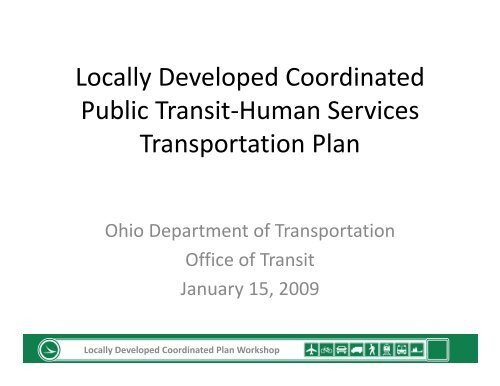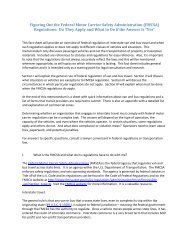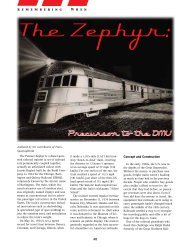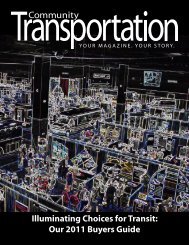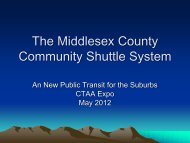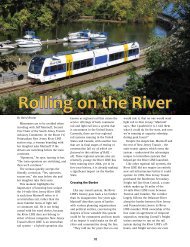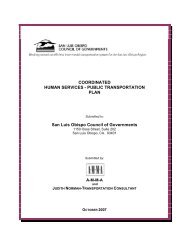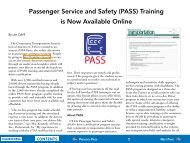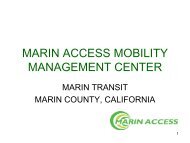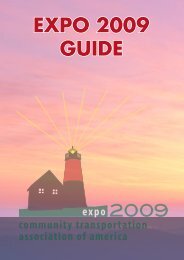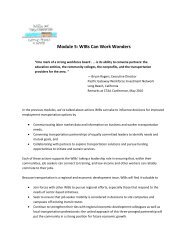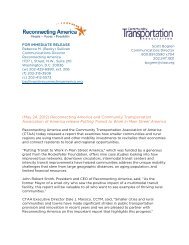Locally Developed Coordinated Plan Workshop - The Community ...
Locally Developed Coordinated Plan Workshop - The Community ...
Locally Developed Coordinated Plan Workshop - The Community ...
You also want an ePaper? Increase the reach of your titles
YUMPU automatically turns print PDFs into web optimized ePapers that Google loves.
<strong>Locally</strong> <strong>Developed</strong> d<strong>Coordinated</strong>dPublic Transit‐Human ServicesTransportation <strong>Plan</strong>Ohio Department of TransportationOffice of TransitJanuary 15, 2009<strong>Locally</strong> <strong>Developed</strong> <strong>Coordinated</strong> <strong>Plan</strong> <strong>Workshop</strong>
Welcome and IntroductionsMarianne FreedAdministratorODOT, Office of Transit
Webcast Participants ‐ ContactInformation• To Pose Questions and Offer Comments andIdeas• Email Address:– Kim White, Training and Compliance OfficerODOT, Office of TransitKim.White@dot.state.oh.us3
History and RequirementsJoshua GearhardtODOT, Office of Transit<strong>Locally</strong> <strong>Developed</strong> <strong>Coordinated</strong> <strong>Plan</strong> <strong>Workshop</strong>4
SAFETEA‐LU• <strong>The</strong> Transportation Reauthorization Bill passed in 2005• Added New Federal Transit Administration Programs• Revised some existing programs• Final FTA Circular issued May 1, 2007– 9045.1‐www.fta.dot.gov/documents/FTA_C_9045.1_New_Freedom.pdfFreedom – 9050.1‐www.fta.dot.gov/documents/FTA_C_9050.1_JARC.pdf– 9070.1Fwww.fta.dot.gov/documents/C9070.1F.pdf<strong>Locally</strong> <strong>Developed</strong> <strong>Coordinated</strong> <strong>Plan</strong> <strong>Workshop</strong>5
New and Revised Federal TransitAdministration Programs• Job Access/Reverse Commute (JARC)• New Freedom• Section 5310 0(h (has many names)– Elderly Individuals and Individuals withDisabilities– Specialized Transportation Program• A.K.A.‐Section 16 or Section 16(B)2<strong>Locally</strong> <strong>Developed</strong> <strong>Coordinated</strong> <strong>Plan</strong> <strong>Workshop</strong>6
JARC‐Section 5316• Existing Program‐ Job Access/ReverseCommute– Connect Welfare recipients and low incometo:• Jobs• Employment related training includingeducation programs and pre‐employment training programs<strong>Locally</strong> <strong>Developed</strong> <strong>Coordinated</strong> <strong>Plan</strong> <strong>Workshop</strong>7
JARC‐Section 5316• Funding– Directly to large urbanized areas (over 200,000in population)– To ODOT for Rural and Small Urban Areas(under 200,000 in population)– From Discretionary to Formula; based on lowincome population in UZA<strong>Locally</strong> <strong>Developed</strong> <strong>Coordinated</strong> <strong>Plan</strong> <strong>Workshop</strong>8
JARC‐Section 5316…• Operating 50/50 (Federal/Local)• Capital l80/20 (Federal/Local)l)• <strong>Plan</strong>ning 80/20 (Federal/Local)<strong>Locally</strong> <strong>Developed</strong> <strong>Coordinated</strong> <strong>Plan</strong> <strong>Workshop</strong>9
Ohio JARC‐Section 5316• Who Can Apply– Public Entities providing Public Transit service– Private non‐profit designated by public toprovide Public Transit service– Public entities who are recipients of the OhioCoordination Program<strong>Locally</strong> <strong>Developed</strong> <strong>Coordinated</strong> <strong>Plan</strong> <strong>Workshop</strong>10
New Freedom‐Section 5317• New Program ‐Beyond ADA Requirements– Targeted toward people with disabilities– Program intent:• Improve public transit service• Provide transportation alternatives• Remove barriers<strong>Locally</strong> <strong>Developed</strong> <strong>Coordinated</strong> <strong>Plan</strong> <strong>Workshop</strong>11
New Freedom‐Section 5317• Funding– Directly to large urban areas (over 200,000 inpopulation) lti – To ODOT for Rural and Small Urban Areas(under 200,000000 in population)– Operating 50/50 (Federal/Local)l)– Capital 80/20 (Federal/Local)<strong>Locally</strong> <strong>Developed</strong> <strong>Coordinated</strong> <strong>Plan</strong> <strong>Workshop</strong>12
Specialized Transportation Program‐Section 5310• Existing Program to provide services to:– Elderly and people with disabilities:• Vehicle Acquisition• Equipment• Mobility Management<strong>Locally</strong> <strong>Developed</strong> <strong>Coordinated</strong> <strong>Plan</strong> <strong>Workshop</strong>13
Specialized Transportation Program‐• Program RequirementsSection 5310– Projects must be derived from a “<strong>Locally</strong><strong>Developed</strong> <strong>Coordinated</strong> <strong>Plan</strong>”– Projects must be competitively selected<strong>Locally</strong> <strong>Developed</strong> <strong>Coordinated</strong> <strong>Plan</strong> <strong>Workshop</strong>14
Specialized Transportation Program‐Section 5310• Funding– Administered by the State (ODOT)– Capital only ‐ 80/20 (Federal/Local)<strong>Locally</strong> <strong>Developed</strong> <strong>Coordinated</strong> <strong>Plan</strong> <strong>Workshop</strong>15
Section 5310 – SpecializedTransportation Program• Who Can Apply for funding in Ohio– Private non‐profit organizations– Public entities in areas:• Without non‐profit organizations available toprovide service• Lead in Ohio Coordination Program project<strong>Locally</strong> <strong>Developed</strong> <strong>Coordinated</strong> <strong>Plan</strong> <strong>Workshop</strong>16
Federal Requirements• Section 5310, 5316 & 5317 applications i “deriveddfrom a locally developed, coordinated public transit‐human services transportation plan” .• Designated Recipients will have to certify that theplan was “developed through a process thatincludes representatives of public, private andnonprofit transportation and human servicesproviders and participation by the public”.<strong>Locally</strong> <strong>Developed</strong> <strong>Coordinated</strong> <strong>Plan</strong> <strong>Workshop</strong>17
What are the REQUIRED elements ofthe <strong>Plan</strong>?• <strong>The</strong>re are four outlined in the federal circular– Assessment of available services that identifiescurrent transportation providers– Assessment of current transportation needs forpersons with disabilities, older adults and peoplewith low incomes<strong>Locally</strong> <strong>Developed</strong> <strong>Coordinated</strong> <strong>Plan</strong> <strong>Workshop</strong>18
What are the REQUIRED elements ofthe <strong>Plan</strong>? (Con’t)– Strategies, activities, and/or projects toaddress the identified gaps between currentservices and needs, as well as opportunitiesto improve efficiencies in service delivery– Priorities for implementation based onresources<strong>Locally</strong> <strong>Developed</strong> <strong>Coordinated</strong> <strong>Plan</strong> <strong>Workshop</strong>19
What are the REQUIRED elements ofthe <strong>Plan</strong>? (Con’t)• “<strong>Plan</strong>s must be developed in good faith incoordination with appropriate planning partners andwith opportunities for public participation.” (Page V‐2, FTA C9070.1F, 5/1/2007)• “<strong>The</strong> lead agency, in consultation with participants,should identify the process for adoption of the plan.”(Page V‐7, FTA C 9070.1F, 5/1/2007)• <strong>The</strong> plan should be updated through a regularupdate cycle, as identified din the <strong>Plan</strong>.<strong>Locally</strong> <strong>Developed</strong> <strong>Coordinated</strong> <strong>Plan</strong> <strong>Workshop</strong>20
Who are the TransportationStakeholders? khld• Area transportation planning agencies• Public transportation providers• Private transportation providers• Non profit transportation providers• Past or current organizations funded under the JARC orSection 5310 program• Passengers and advocates• Human service partners• Others‐Anyone interested in Transportation for TargetPopulations<strong>Locally</strong> <strong>Developed</strong> <strong>Coordinated</strong> <strong>Plan</strong> <strong>Workshop</strong>21
Why Participate?• Advantages– You represent your customer base, public transit orhuman service provider, in their quest for mobilitychoices– Will assure that JARC, New Freedom and 5310 fundsare used for meeting the particular and unique needsof the residents of your community.– Resources are limited for everyone and increasingefficiency through coordination makes sense.<strong>Locally</strong> <strong>Developed</strong> <strong>Coordinated</strong> <strong>Plan</strong> <strong>Workshop</strong>22
Developing the <strong>Plan</strong>Robbie SarlesRLS and Associates<strong>Locally</strong> <strong>Developed</strong> <strong>Coordinated</strong> <strong>Plan</strong> <strong>Workshop</strong>23
Low Cost/No Cost Methods toDevelop a <strong>Plan</strong>• Use other plans as model• ODOT website• CTAA website• Transit system website• Ohio peers transit systemso ODOT staff can assist<strong>Locally</strong> <strong>Developed</strong> <strong>Coordinated</strong> <strong>Plan</strong> <strong>Workshop</strong>24
Low Cost/No Cost Methods toDevelop a <strong>Plan</strong> (Continued)• Follow template• ODOT checklist• WVDOT Coordination Toolkito Comprehensive versionoMinimal versiono <strong>Plan</strong> update version<strong>Locally</strong> <strong>Developed</strong> <strong>Coordinated</strong> <strong>Plan</strong> <strong>Workshop</strong>25
Low Cost/No Cost Methods toDevelop a <strong>Plan</strong> (Continued)• Supplemental outside assistance• Peer transit system• Larger transit system• Incorporate in neighboring transit system plan• Regional or local planning agencies• Universities / community colleges• Other agencies• Consultants<strong>Locally</strong> <strong>Developed</strong> <strong>Coordinated</strong> <strong>Plan</strong> <strong>Workshop</strong>26
Low Cost/No Cost Methods toDevelop a <strong>Plan</strong> (Continued)• Types of supplemental assistance• Overview guidance• Technical analysis• Meeting facilitation• Alternative development• Project selection criteria• Objective project evaluation process<strong>Locally</strong> <strong>Developed</strong> <strong>Coordinated</strong> <strong>Plan</strong> <strong>Workshop</strong>27
WV Toolkit• A compilation of information and resources• Tool for communities pursuing transportationcoordination• Guide for developing local coordination plans<strong>Locally</strong> <strong>Developed</strong> <strong>Coordinated</strong> <strong>Plan</strong> <strong>Workshop</strong>28
WV Toolkit (Continued)• Toolkit contains• Introduction explaining the background forthe toolkit• Frequently Asked Questions (FAQ)• Getting started• Coordination briefs• References and resources• Sample Forms and Templates<strong>Locally</strong> <strong>Developed</strong> <strong>Coordinated</strong> <strong>Plan</strong> <strong>Workshop</strong>29
Step 1: Obtain Basic Understandingof Coordination• Why the emphasis on coordination now?• When is coordination effective?• Will coordination save me money?• What will coordination cost?• What are the obstacles to coordination?• Who needs to be involved in a coordinationeffort?<strong>Locally</strong> <strong>Developed</strong> <strong>Coordinated</strong> <strong>Plan</strong> <strong>Workshop</strong>30
Step 1: Obtain Basic Understandingof Coordination (Continued)• What problems can coordination address?• What are the goals for coordinateddtransportation services?• How does coordination work?• What are the benefits of coordination?• Why have some coordinated systems failed?• Why have many coordinated systems succeeded?<strong>Locally</strong> <strong>Developed</strong> <strong>Coordinated</strong> <strong>Plan</strong> <strong>Workshop</strong>31
Step 2: Create an Outline of Your<strong>Plan</strong>• Coordination <strong>Plan</strong> Sample Table of Contents• I – Introduction and Overview• II – Inventory and Analysis of Existing Conditions• III –Stakeholder Assessment• IV – Transportation Provider Inventory• V – Identification of Unmet Mobility Needs• VI – Coordination Alternatives• Goals, Objectives, and Implementation Strategies<strong>Locally</strong> <strong>Developed</strong> <strong>Coordinated</strong> <strong>Plan</strong> <strong>Workshop</strong>32
Step 2: Create an Outline of Your<strong>Plan</strong> (Continued)• Coordination <strong>Plan</strong> Sample Table of Contents(Continued)• VII – Action <strong>Plan</strong>• Selection Criteria• Prioritization• Implementation Strategy• VIII ‐ Adoption and Approval of <strong>Plan</strong>• IX – <strong>Plan</strong> Update• Appendices –Stakeholder and Public InvolvementRecord<strong>Locally</strong> <strong>Developed</strong> <strong>Coordinated</strong> <strong>Plan</strong> <strong>Workshop</strong>33
Step 3: Develop Public Participation /Outreach Strategy• Example of outreach activities• Focus groups• Public hearings• Surveys• Interviews• Public forums, workshops, open houses• Meetings –targeted populations<strong>Locally</strong> <strong>Developed</strong> <strong>Coordinated</strong> <strong>Plan</strong> <strong>Workshop</strong>34
Step 3: Develop Public Participation /Outreach Strategy (Continued• Notification methods• Newspaper notices• Flyers• Direct mailing• Media public service announcements• E‐Mail<strong>Locally</strong> <strong>Developed</strong> <strong>Coordinated</strong> <strong>Plan</strong> <strong>Workshop</strong>35
Step 4: Identify Who Should beInvited to Participate• Identify stakeholders• Comprehensive list• Core group<strong>Locally</strong> <strong>Developed</strong> <strong>Coordinated</strong> <strong>Plan</strong> <strong>Workshop</strong>36
Step 5: Collect Population andDemographic Data• Major trip generators• Major origin and destination data• Typical destinations outside of service area• County demographic profiles<strong>Locally</strong> <strong>Developed</strong> <strong>Coordinated</strong> <strong>Plan</strong> <strong>Workshop</strong>37
Sources of Demographic Data• U.S. Census• County Profile• County Commissioners• Chamber of Commerce• Department of Economic Development• Agriculture Extension Office• School System<strong>Locally</strong> <strong>Developed</strong> <strong>Coordinated</strong> <strong>Plan</strong> <strong>Workshop</strong>38
• Survey• InterviewsStep 6: Inventory ExistingTransportation Services<strong>Locally</strong> <strong>Developed</strong> <strong>Coordinated</strong> <strong>Plan</strong> <strong>Workshop</strong>39
Step 7: Conduct Gap Analysis /Needs Assessment• Compare supply of service with demand• Identify current coordination efforts• Identify challenges to coordination• Develop goals for coordination<strong>Locally</strong> <strong>Developed</strong> <strong>Coordinated</strong> <strong>Plan</strong> <strong>Workshop</strong>40
Step 8: Identify Potential lProjects• Describe potential projects<strong>Locally</strong> <strong>Developed</strong> <strong>Coordinated</strong> <strong>Plan</strong> <strong>Workshop</strong>41
Step 9: Evaluate and PrioritizeProjects• Develop selection criteria• Evaluate potential projects• Prioritize potential projects<strong>Locally</strong> <strong>Developed</strong> <strong>Coordinated</strong> <strong>Plan</strong> <strong>Workshop</strong>42
Step 10: Create ImplementationStrategy<strong>Locally</strong> <strong>Developed</strong> <strong>Coordinated</strong> <strong>Plan</strong> <strong>Workshop</strong>43
Step 11: Finalize <strong>Plan</strong>• Document planning process• Document results• Document public participation / outreach• Adopt plan<strong>Locally</strong> <strong>Developed</strong> <strong>Coordinated</strong> <strong>Plan</strong> <strong>Workshop</strong>44
Step 12: Establish Procedure andTimeline for Updating <strong>Plan</strong><strong>Locally</strong> <strong>Developed</strong> <strong>Coordinated</strong> <strong>Plan</strong> <strong>Workshop</strong>45
Examples of Coordination Activities• Information and Referral• Mobility Managers• <strong>Plan</strong>ning• Transportation Brokerages• Grants Management• Volunteer Pools• Specification Development• Vehicle, Equipment, and FacilityPurchases• Training• Joint Dispatch and Scheduling• Joint Policy/ProcedureDevelopment• Call Centers• Passenger Aides/Escorts• Guaranteed Ride Home• Joint Purchasing• Shared Supplemental ServiceContracts• Vehicle Sharing• ITS/GPS• Trip Sharing<strong>Locally</strong> <strong>Developed</strong> <strong>Coordinated</strong> <strong>Plan</strong> <strong>Workshop</strong> 46
Developing the <strong>Plan</strong>Carla LakatosLakatos Group, Ltd.<strong>Locally</strong> <strong>Developed</strong> <strong>Coordinated</strong> <strong>Plan</strong> <strong>Workshop</strong>47
TargetPopulationsElderly Low Income Disabled<strong>Locally</strong> <strong>Developed</strong> <strong>Coordinated</strong> <strong>Plan</strong> <strong>Workshop</strong> 48
Benefits toUsers and <strong>Community</strong><strong>Locally</strong> <strong>Developed</strong> <strong>Coordinated</strong> <strong>Plan</strong> <strong>Workshop</strong>49
Lakatos Group Experience• Example Agency: Ohio Coordination Project Lead• Background:• As an Ohio Coordination Project, serves the publictransportation and human service transportation needs ofthe County since 1999 (County Commissioners aregrantee).• Coordination Project includes 18 participating agenciesand is the principle provider of transportation for seniorsin Union County.<strong>Locally</strong> <strong>Developed</strong> <strong>Coordinated</strong> <strong>Plan</strong> <strong>Workshop</strong>50
Lakatos Group Experience• Example Lead Agency: Four County <strong>Community</strong> ActionCommission i (CAC)• Background:• <strong>Plan</strong> covered Three of the Four Counties• CAC operates an Ohio Rural Transit System in one of thethree counties. <strong>The</strong>re are no public transportationservices in the remaining two counties.• <strong>The</strong> Fourth County elected to develop its own plan.<strong>Locally</strong> <strong>Developed</strong> <strong>Coordinated</strong> <strong>Plan</strong> <strong>Workshop</strong>51
Key Challenge:Generating local interest in and commitment todeveloping a Local <strong>Coordinated</strong> <strong>Plan</strong>.• Recommended Initial Steps:• Identify a Lead Agency• Appoint a Steering Committee for process oversight &recommendation/adoption of a final <strong>Coordinated</strong> <strong>Plan</strong>• Convene the Steering Committee to:• Assure a common level of understanding of the planning processand the economic and social benefits of a coordinated approach.• Generate a commitment to process oversight<strong>Locally</strong> <strong>Developed</strong> <strong>Coordinated</strong> <strong>Plan</strong> <strong>Workshop</strong>52
Key Challenge:Generating local interest in and commitment todeveloping a Local <strong>Coordinated</strong> <strong>Plan</strong>.• Recommended Initial Steps (continued):• Approve work scope and schedule (be careful of tighttimelines!)• Provide support in identifying all interested parties andcontact persons• Approve process participation plan• Identify broad key issues and planning goals (throughinput from Steering Committee and other keystakeholders).<strong>Locally</strong> <strong>Developed</strong> <strong>Coordinated</strong> <strong>Plan</strong> <strong>Workshop</strong>53
Key Challenge:Developing & Implementing Specific Strategies toAssure Effective <strong>Plan</strong>ning Process Participation• Goal 1:Raise interested parties’ level of understanding of theplanning process and identify how interested parties canbecome involved.• Examples:• Develop database of all interested parties and contact persons.• Develop public informational materials –leaflet, websiteinformation• Develop a media relations plan.<strong>Locally</strong> <strong>Developed</strong> <strong>Coordinated</strong> <strong>Plan</strong> <strong>Workshop</strong>54
Key Challenge:Developing & Implementing Specific Strategies toAssure Effective <strong>Plan</strong>ning Process Participation• Goal 2:• Ensure interested parties are provided with adequate,appropriate it and meaningful opportunities to participate i t inthe planning process.• Examples:• Outreach to stakeholder (surveys, phone calls, etc.)• Use of representative Steering Committee and working groups.• Distribution of contact information for providing suggestions onkey plan elements.<strong>Locally</strong> <strong>Developed</strong> <strong>Coordinated</strong> <strong>Plan</strong> <strong>Workshop</strong>55
Key Challenge:Developing & Implementing Specific Strategies toAssure Effective <strong>Plan</strong>ning Process Participation• Goal 2 Examples (continued):• Media notices of availability of draft plan for review andcomment.• Computer based participation through key websites.• Public availability of draft plan at key locations.• Public meetings.• Assure that the Steering Committee has an opportunity toreview all public comments.<strong>Locally</strong> <strong>Developed</strong> <strong>Coordinated</strong> <strong>Plan</strong> <strong>Workshop</strong>56
Key Challenge:Developing & Implementing Specific Strategies toAssure Effective <strong>Plan</strong>ning Process Participation• Goal 3:• Identify and involve target populations (low income,elderly, persons with disabilities) in the planning process.• Examples:• Identify all agencies that represent or assist these populationsand maintain contact/mailing list.• Identify ways of reaching and involving target population.<strong>Locally</strong> <strong>Developed</strong> <strong>Coordinated</strong> <strong>Plan</strong> <strong>Workshop</strong>57
Key Challenge:Developing & Implementing Specific Strategies toAssure Effective <strong>Plan</strong>ning Process Participation• Goal 4:• Use the Steering Committee to the fullest extent to reachinterested parties in the planning area – eg e.g., citizens,representative agencies, and local public officials.• Examples:• Steering Committee reviews stakeholder database, publicinformational materials, public comment, survey results, etc.• Steering Committee appoints a working group to develop actionstrategies.• Steering Committee formally accepts and recommends the Final<strong>Coordinated</strong> <strong>Plan</strong>.<strong>Locally</strong> <strong>Developed</strong> <strong>Coordinated</strong> <strong>Plan</strong> <strong>Workshop</strong>58
Key <strong>Plan</strong>ning Challenge:Example Ohio Coordination Project• Issue:<strong>The</strong> Coordination Project is perceived as a fully effective coordinationproject. Obtaining full participation of private businesses, public agencies,local providers/funders, and locally elected officials in the planning effortwas the key challenge.• Response:<strong>The</strong> local Chamber of Commerce was contacted and included a survey of itsmembers in the <strong>Coordinated</strong> <strong>Plan</strong>. In addition, the participants agreed thatfurther planning participation could be encouraged by requesting that CEOsof all major publically supported agencies, and the County Commissioners tosign off on the final plan.<strong>Locally</strong> <strong>Developed</strong> <strong>Coordinated</strong> <strong>Plan</strong> <strong>Workshop</strong>59
Key <strong>Plan</strong>ning Challenge:Example Ohio Coordination Project• Issue:Realization that certain high‐prioritized strategies involvedorigins/destinations and transportation providers outside of Union County.• Response:Encourage more of a regional approach in future plan updates.<strong>Locally</strong> <strong>Developed</strong> <strong>Coordinated</strong> <strong>Plan</strong> <strong>Workshop</strong>60
• Issue:Key <strong>Plan</strong>ning Challenge:Example Multi‐County CACTwo of the counties without Public Transit had limited experience with inter‐agency dialogue, understanding of need and transportation coordination.This resulted in challenges in generating stakeholder interest and anunderstanding of unmet need.• Response:Work closely with stakeholder and working groups. Encourage an ongoing,dynamic planning process. Realize that the planning process itself is ameaningful outcome.<strong>Locally</strong> <strong>Developed</strong> <strong>Coordinated</strong> <strong>Plan</strong> <strong>Workshop</strong>61
• Issue:Key <strong>Plan</strong>ning Challenge:Example Multi-County CACFinding meaningful coordination opportunities among three (3) verydifferent counties.• Response:Generate prioritized i i dimplementation i strategies for each county. Assure adynamic planning process with relatively frequent <strong>Plan</strong> updates and intercountycommunication. Find an early success that can generate furtherinterest in inter‐county coordination. Realize that the planning process itselfis a meaningful outcome.<strong>Locally</strong> <strong>Developed</strong> <strong>Coordinated</strong> <strong>Plan</strong> <strong>Workshop</strong>62
Summary Recommendations:• Using a Steering Committee to adopt a process plan and provideoversight will assist in moving the effort forward.• Using available resources such as a planning process outline,stakeholder and community survey instruments, etc. isrecommended.• Developing & implementing specific strategies to assureeffective planning process participation is critical albeit timeconsuming.• Involving locally elected officials and other key influencers tothe fullest extent possible will assist with local buy‐in.<strong>Locally</strong> <strong>Developed</strong> <strong>Coordinated</strong> <strong>Plan</strong> <strong>Workshop</strong>63
Summary Recommendations:• Developing and monitoring timelines and milestones isimportant but focus first on generating the fullestparticipation possible (even if timelines must slip).• Assuring that the planning process is dynamic – that is,providing regular plan updates and reviews will result in thefullest benefits to your community.• Realize that the planning process itself is a meaningfuloutcome (creating/encouraging inter‐agency, public/privatedialogue).<strong>Locally</strong> <strong>Developed</strong> <strong>Coordinated</strong> <strong>Plan</strong> <strong>Workshop</strong>64
Resources• ODOTwww.dot.state.oh.us/Divisions/Local/Transit/Pages/default.aspx• WVDOTwww.wvdot.com/z_buses/z_buses.htm• CTAAwww.ctaa.org• FTA United We Ridewww.unitedweride.gov• National RTAP• www.nationalrtap.org<strong>Locally</strong> <strong>Developed</strong> <strong>Coordinated</strong> <strong>Plan</strong> <strong>Workshop</strong>65
Questions???<strong>Locally</strong> <strong>Developed</strong> <strong>Coordinated</strong> <strong>Plan</strong> <strong>Workshop</strong>66


